9 Best Photo Editing Apps for Mac (Free & Paid)

Photo Editing Apps has a number of options available for enhancing and editing photos. In addition to more sophisticated capabilities such as support for layered editing, sophisticated color correction, and more, they provide basic functions such as text cropping and enhancement, filters, and more. Some apps for photo editing also have AI capabilities that allow for automatic editing of photos with straightforward text instructions. For photo processing, the majority of people use a Mac.
Abstract;
- Because of its high performance, high-quality screens, and well-developed photo editing software, the majority of users prefer to use Macs for photo editing.
- For Mac, there are many entry-level and advanced photo editing applications available. These apps allow you to convert images with basic to complex functionality.
- We’ll review ten different Mac Photo Editing Apps in this guide. Several well-known Adobe programs are included in the list. Open source programs like GIMP, entry-level editing programs like Fotor, and built-in Mac options are all available.

In this post, we’ll introduce you to the top ten Mac Photo Editing Apps if you’re looking for the best. The list includes Mac built-in photo editing tools, open source photo editing software, and basic to professional Photo Editing Apps.
Best Photo Editing Apps for Mac
- Adobe Photoshop: Proven tools for digital art, graphic design, and photo editing that meet industry standards.
- Affinity Photo App: Professional caliber photo editing is available with a one-time purchase of the Affinity Photo app.
- Apple Photos: Simple photo management and organization, compatible with Apple products.
- GIMP: Editing tools that are powerful, customizable and open source.
- Foter Photo Editor: Basic editing tools and templates that are easy to use.
- Adobe Lightroom: Non-destructive editing and workflow-focused photo organization and editing.
- Darktable
- Pixlr: A web-based, cloud-based photo editing platform with simple tools.
- Luminar Neo Photo Editor: User-friendly UI, AI-powered editing tools.
1) Adobe Photoshop

The most popular and latest photo editing software for Mac is called Adobe Photo. It provides powerful and advanced photo editing features. This software works with Apple’s latest M-series silicon processors. The Mac App Store does not offer the Adobe Photoshop application. Alternatively, you can download and install the software on your Mac directly from Adobe’s official website. The app costs $20 a month and is available free for seven days. The software can also be purchased together with an app package, which costs $54.99 per month and covers all Adobe programs.
Professional photo editing is the goal of Adobe Photoshop. Viewing Adobe’s free tutorials can help you learn how to use Adobe Photoshop if you’re new. With support for layers, adjustment layers, healing brushes, cropping tools, color balance, mix modes, clone stamp tools and more, the software offers a range of image editing capabilities from basic to advanced. It also supports multiple plugins, AI-powered enhancements, and 3D editing.
Basic photo editing features include brightness adjustment, image cropping, contrast adjustment, and more. The app includes powerful image editing tools, including tools for auto-correcting photos, support for multiple layers, sophisticated color management features, support for custom brushes, tools for cloning stamps, blending Includes tools and more. The program is also available for non-destructive modification. Photoshop includes realistic drawing, motion-based multimedia, and 3D graphics editing capabilities. Additionally, the software offers versatility for a range of photographic demands by supporting file editing in RAW and other professional formats. This software offers basic video editing features in addition to photo editing features.
Additionally, you can add other plugins to enhance the functionality of the app with the support of the app. Plugins that are popular include Noiseware, which reduces noise in images, the Nik Collection plugin, which provides extensive photo editing features, and Portrait, which is used for skin retouching. Is. The user interface is straightforward and intuitive. The software has many tools that make it easy to edit images. It includes custom settings that allow you to add settings when editing photos, as well as a precise selection tool for depth editing. An additional feature of the program is a history panel that records all image modifications.
Multiple export formats and options, including social media integration, are supported by Adobe Photoshop. The image can be exported and shared directly on social media. Recently, Adobe unveiled new generative tools for image editing with artificial intelligence. For convenience, Generative features are accessible with Adobe photo editing tools. Additionally, text prompts are supported by Generative Fill, which lets you write text and let the AI manipulate an image on your behalf.
It’s a premium product with multiple subscription choices, including Creative Cloud All Apps plans, photography plans, single-app subscriptions, and special savings for businesses, teachers, and students. You must have Mac OS 10.5 or later to use the software. It’s compatible with Behance, Lightroom, Stock, and other Adobe programs, among other Adobe products. For professional photo editing and creative work, Adobe is the best choice for photographers, illustrators and graphic designers.
Pros:
- Because Photoshop is widely used in the industry, it is a necessity for many professionals and businesses.
- Adobe Photoshop has many basic to advanced photo editing options.
- Uses straightforward language prompts and creative AI to edit photos.
Cons:
- Use of a Pro subscription is required.
- The program is not user-friendly for beginners and requires experience to operate.
- Additionally, the app consumes a lot of resources.
Install Adobe Photoshop on Mac.
2) Affinity Photo App
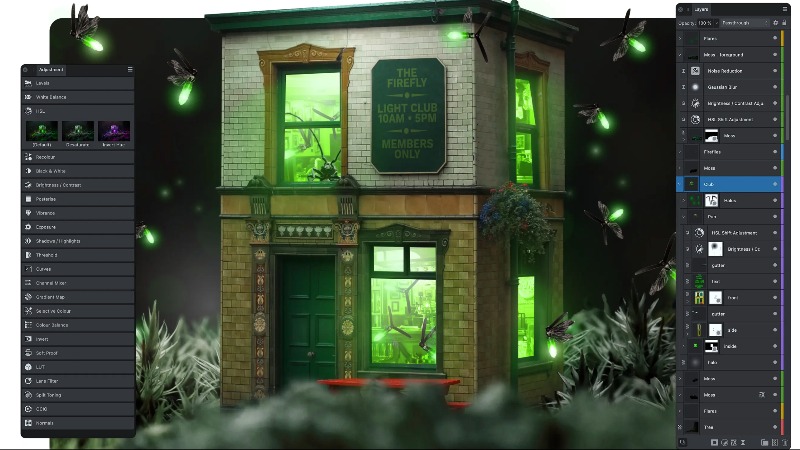
If you’re looking for a better solution than Adobe Photoshop, I recommend Affinity Photo. It has a large feature set and provides important features like Adobe Photoshop. This program is best suited for novice or expert photographers looking for a less expensive alternative to the Mac version of Adobe Photoshop. Alternatively, you can purchase the app only once instead of committing to an annual or monthly subscription.
Photoshop and its user interface are comparable. The software has capabilities for both novice and expert photo editors. Crop, rotate, rotate, resize, change color, delete unwanted objects, and more are among the basic photo editing features of the app. Additionally, it provides advanced capabilities including cloning, frequency separation, touch-up, dodge, and burn tools. In addition, it offers multi-layer composition, blending mode, edge tools for quick selection and simple editing and much more. It’s possible to add and style text, create unique brushes, and sync images.
Also included are 360° image editing, panoramic stitching, and HDR integration through the program. Multiple export options, batch processing, macros, focus stacking, noise reduction, and other features are also supported. Additionally, the software has a workspace for editing RAW files only. Like Photoshop, Affinity Photo offers a wide range of plug-ins that allow users to enhance the program’s features and functionality. This program works with a wide range of popular Photoshop plugins.
Affinity Photo, a premium app, costs $69.99 for a one-time purchase. The iPad version of the software costs $18.49/17.99. Mac and Windows versions of the program are also available for 30-day free trials. From the official website, you can download and install the Affinity Photo program on your Mac.
Pros:
- A cost-effective choice
- Provides an interface similar to Photoshop.
- Expert provides a large selection of features and tools for photo editing.
- Includes support for Photoshop plugins and an online store with more content.
Cons:
- A few features associated with AI are lacking.
- Not suitable for beginners.
Install the Affinity Photo app on your Mac.
3) Apple Photos
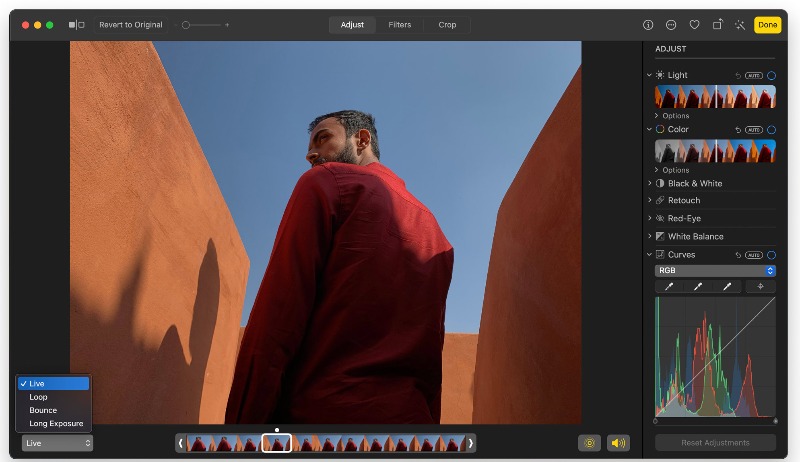
If you’re looking for a straightforward Mac photo editing App, Apple Photos is a great choice. Integrated within the Mac, Apple Photos software provides basic editing capabilities such as cropping, rotating, adjusting exposure and color, removing red-eye, adjusting white balance, and more. Also includes adjustable controls for brightness, contrast, and tone. You can use the Apple Photos app for free. The Apple Images app isn’t just for taking photos. Videos can also be edited with it. It works best for users who don’t want to install any third-party apps and just need a basic photo editing tool.
A number of photo editing features are supported by the Apple Photos app. Many filters can be used to process images. Built-in filters in the Photos app let you change the look of your photos and videos. The software also has an automatic enhancement tool, which enables you to modify the contrast and color of the edited photo or video.
The user interface is straightforward and intuitive. You launch the Mac version of Apple Photos, select the photo you want to edit, and then click the Edit button in the upper-right corner of the window. It shows the integrated editing features of photo apps. You can access editing elements like white balance, contrast, color and more in the sidebar. There’s also a Reset Adjustments option, to return picture settings to their original defaults.
Apple Photos allows you to restore edits and restore the original look of your photos while preserving the original. Apple Photos makes it easy to create duplicate photos if you want to play around.
If you’re looking for a straightforward photo editing program without having to install a third-party app, Apple Photos is your best bet overall. Videos can be edited using Apple Photos’ basic video editing tools. The app is free to use. All Apple devices connected to the same iCloud account automatically store any edits you make to a photo in the Apple Photos app.
Pros:
- It’s free to use and comes with macOS pre-installed.
- Provides a decent range of editing tools.
- Combine photo and video editing in one place.
Cons:
- Not suitable for sophisticated image editing.
Download the latest version of Apple Photos for Mac.
4) GIMP
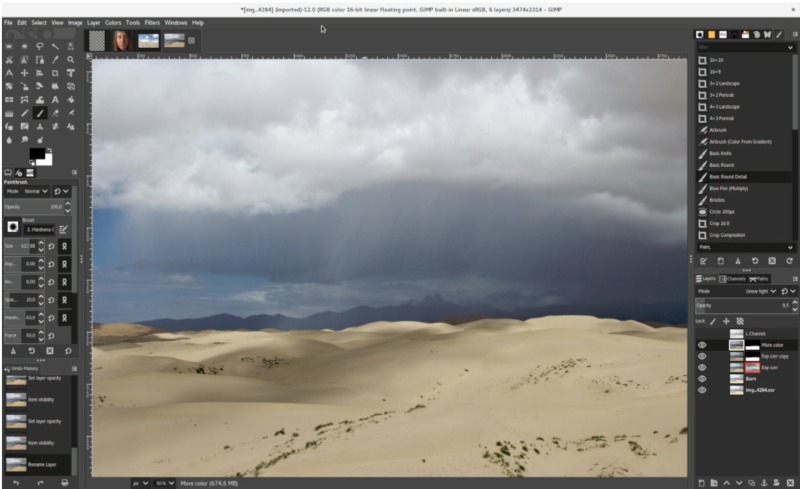
GIMP, often known as the GNU Image Manipulation Program, is an open-source photo editing App that can be used with Windows, Linux, and macOS. This program is available for free and offers many photo editing options for both novice and expert users. If you’re looking for a free, open-source alternative to expensive commercial software like Photoshop, GIMP is a great choice.
Although the UI is a little old, you can get used to it eventually. This software provides basic to intermediate photo editing capabilities. With the software, you can resize them, crop them, and accomplish other tasks. Advanced photo editing features include color correction, layer stacking, using the healing tool to fix minor mistakes, and even editing RAW images directly from your camera. To extend its functionality, GIMP also accepts external plugins.
For those looking for a free and open-source Photo Editing Apps for their Mac, GIMP is the best option overall. For both novice and expert users, it provides both simple and advanced photo editing features. GIMP is free to use. It is available for download and installation on your device through GIMP’s official website.
Pros:
- GIMP is open source and completely free.
- Compatibility on multiple platforms: accessible on Windows, macOS and Linux
- Provides basic and advanced editing options for a range of simple to complex image adjustments.
- Users are able to rearrange tools, add shortcuts and change the interface to suit their preferences.
- Runs smoothly on older or less powerful machines and uses less memory.
- Allows the addition of third-party plugins for functionality.
Cons:
- Difficult for newcomers
- A better user interface would be ideal.
Get GIMP photo editing software for Mac.
5) Fotor Photo Editor

If you’re looking for a simple, user-friendly alternative to sophisticated image editing Apps like Photoshop and Affinity Pro, Footer is your best bet. With basic to complex image editing tools including cropping, rotating, resizing, curves, layers and more, the software has an easy-to-use UI. This program is a great choice for anyone who needs to quickly create and edit content for social media as it also supports templates.
Footer’s image editing features include basic tools such as resizing, rotating, cropping, and color adjustments. Additionally, there are functions to improve fuzzy images and sharpen images. Red-eye reduction and artistic effects can also be applied with this program. Advanced features including curves and layers for HDR composition, skin smoothing, distortion correction, and fine-tuning are also available. In addition, it offers templates for creating content for social media and other platforms. In addition, it provides lens correction, noise reduction, and other custom tweaks.
The app’s UI is straightforward and user-friendly. This app is designed for beginners who want to edit their photos quickly. Unlike Photoshop, which uses layers and toolbars, Footer allows you to edit and apply effects to the entire image. You can download the footer app for free. For $8.99 a month or $39.99 a year, you can get a Fotor Pro subscription to access other features like lens correction and noise reduction. Additionally, Footer offers a more expensive subscription called Footer Pro+, which includes even more sophisticated features and costs $19.99 per month or $89.99 per year.
Pros:
- Features a basic, user-friendly design that’s ideal for beginners.
- Provides both entry-level and advanced editing tools.
- Includes social media content design templates.
- version is available for free.
- Enables simultaneous editing of multiple images.
Cons:
- Not suitable for users looking for a feature-rich alternative to high-end software like Photoshop.
Get the Mac version of Footer Photo Editor.
6) Adobe Lightroom

For raw image editing, Adobe also provides Adobe Lightroom. Adobe Photoshop’s main function is graphics editing, which is the main difference between it and Adobe Lightroom. Photoshop can be used to edit minute features in an image, create entirely new images, and more. In contrast, Adobe Lightroom is designed for editing raw files and offers many other features, including batch processing of multiple images at once. If you want a simple photo editing tool that makes managing your photos easy and provides a basic editing experience, Adobe Lightroom is the best option.
Adobe Lightroom offers a number of simple and advanced built-in photo editing features. It’s easy to import multiple images, tag them, organize them according to metadata, and group them into sets. Adobe Lightroom offers image import, editing and export workflows in place of discrete photo editing functions. Because Adobe Lightroom allows non-destructive image editing, the original images remain unchanged. The image can be re-imported and modified to suit your needs. Lightroom has video editing capabilities in addition to photo editing, including presets, cropping, retouching, and adjusting contrast, highlights, and color.
Compared to Adobe Photoshop, the user interface is straightforward and easy to use. The program easily interfaces with other Adobe programs. Images can be exported to Photoshop for depth editing. If you’re just getting started, use the free tutorials provided by Adobe. The Adobe Lightroom app is not free. The app is available with a $9.99/month subscription. Creative Cloud and Adobe Photoshop plans are also included. On mobile devices, Adobe Lightroom can also be downloaded for free.
Pros:
- Provides powerful tools for editing photos.
- Use the app to manage all your photos.
- Seamless interaction with other Adobe programs such as Photoshop for sophisticated editing.
- Make editing more efficient by streamlining the process.
- Allows device access and editing of images by syncing with Adobe Cloud.
Cons:
- An annual or monthly subscription is required.
- For beginners, it may take some time to learn all the features.
- Above and beyond the basic plan, additional cloud storage may cost extra.
Download Adobe Lightroom for Mac
7) Darktable
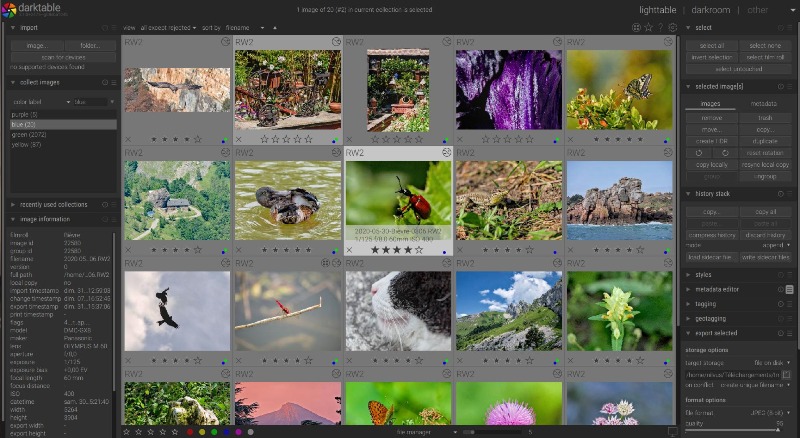
If you’re interested in open source software, try Darktable, a free and open source image editing App. The Mac Apps provides free photo editing tools for you to use. You can add amazing effects, adjust brightness and color, resize, and even draw shapes.
It also has tools that enable you to organize and manage all your photos in one place. Moreover, Darktable enables direct camera capture and image editing. The app is free to download. From the official Darkable website, you can download and install the program on your Mac. The program is comparable to GIMP and is lightweight. It works with the majority of Macs.
Download Darktable Photo app for Mac
8) Luminar Neo – Photo Editor

Beginners and professionals looking for photo editing App will find Luminar an easy-to-use Mac photo editor with AI-powered capabilities. Various AI photo editing functions are available in the app including Sky AI, Accent AI, Skin AI, and others. You can save time and perform sophisticated image editing with the help of these AI tools.
Additionally, the program has both simple and sophisticated manual image editing tools. Basic photo editing App features include cropping, rotating, adjusting brightness and contrast, and more. The program also has advanced capabilities such as layer support, power line and dust spot removal, high dynamic range custom color profile processing, professional grade tools, and super contrast for changing tonal ranges. Additionally, it offers AI photo editing capabilities. Both manual tools and AI features are offered. To apply changes to the photo, just tap on any tool.
The user interface is straightforward and intuitive. It provides a simple interface for workflow. Images can be edited, imported from your device, and exported in a variety of formats. The app has three levels of membership and is available for free to try. A monthly subscription costs $8.99, an annual subscription costs $49.99, or you can pay $99.99 for a one-time, lifetime purchase.
Pros:
- Provides a variety of AI-powered services, including Sky AI, Relight AI, and
- Easy editing with AI portrait bokeh.
- Both novices and experts can use the simple, user-friendly design.
Cons:
- Reduced filtering and tweaking possibilities.
Get the Mac program Luminar Neo Photo Editor.
9) Pixlr
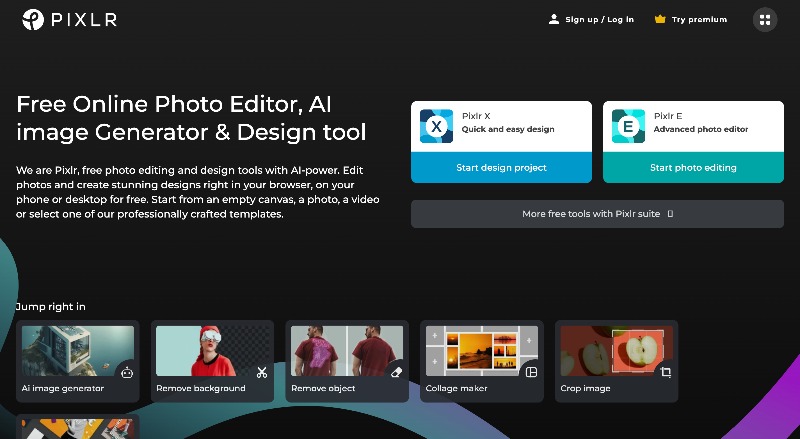
For Mac users looking for a straightforward cloud-based photo editor App, Pixlr is the perfect choice. On your Mac, it provides both basic and advanced photo editing features. In addition to template support, it provides a Pixlr library for storing and retrieving projects and images.
Basic photo editing functions such as cropping, resizing, and background removal are all included in the program. You can also annotate, sketch or write on your photos using this software. It is also compatible with filters. Your converted images can be exported or saved in PNG, JPEG, BMP, or TIFF formats and shared directly on social media.
Additionally, Pixlr provides sophisticated photo editing tools such as Focal Blur for added emphasis, Color Splash to intensify colors, and Double Exposure for layer effects. Choose from a variety of effect packages, use overlays to change the tone of an image, and more. Any adjustments you make to the images are traceable, and you can go back and make more at any time.
Pros:
- Many users can use Pixlr because it has a good collection of editing tools and is available in a free version.
- Provides a straightforward user interface that is ideal for both novice and experienced users.
- You don’t need to register for an account to edit photos.
- Provides a wide selection of creative editing tools, filters and effects.
- Help with templates.
- Enables users to store and retrieve their projects and images from the Pixlr library.
Cons:
- It’s possible that some of the more advanced editing tools found in high-end software are missing.
Get the Pixlr app on your Mac.
Note: MacShop does not offer the Pixelr app. The software is available for download through third-party apps such as Softonic. Before installing the file on your Mac, be sure to scan it.
ALSO SEE:
- Best VPN Browsers
- Free Offline GPS Apps
- Free Invoicing Apps
- Remove Background Noise
- Best Bottleneck Calculators
- Online Keyboard Testers
- Chromebook Note Taking Apps
Find The Next Best Photo Editing App For Mac
For Mac, there are many free photo editing Apps available.This list should be helpful to you, I hope. Finally, Luminar Neo, Adobe Lightroom, Affinity Photo, and Adobe Photoshop are all options for experts. If you are a casual user, you can experiment with Apple Photos, Fotor and Pixlr. If you’re looking for a free alternative, try the free versions of Pixlr and GIMP. Please feel free to leave more recommendations in the comments section below.
How to Choose the Best Mac Video Editing Apps
Features: The main difference between video applications is their features. Consider the functions you need from photo editing software. Find basic editing capabilities in a photo editing program such as crop, rotate, brightness adjustment, simple filter application, and more. Find in-app retouching, advanced editing tools, plugin support and more for photo editing. These are the most common features that a photo app should have. Features are selectable based on your requirement.
Basic editing tools: Simple editing tools include brightness, contrast, saturation, rotation, resizing, and cropping.
Advanced editing tools: Examples of editing tools include layer support, masking, blending modes, advanced color correction, and more.
Effects and Filters: A huge selection of adjustable effects and preset filters.
Support for raw files: Manage and edit raw files from mobile devices and camera brands.
Retouching tools: Retouching tools include skin smoothing, red eye correction, acne removal, and blemish removal.
Text and typography tools: Use different fonts and style options to add and edit text.
Brushes and drawing tools: Custom brushes, pencils, and other drawing tools are available for use in creating creative effects.
Support for High Dynamic Range (HDR): Ability to edit and combine multiple images.
Noise reduction tools: High ISO images can be made with little or no noise.
Batch Processing: The ability to edit multiple images at once and make the same changes to each at the same time.
Connectivity to cloud services: Cloud integration enables device sharing and synchronization.
Plugin Support: Ability to add new features using plugins from other developers.
Editing and Editing Possibilities in 3D Images: Tools for 3D Editing.
Color Grading Tools: Advanced tools for achieving a specific style or atmosphere.
AI-powered improvements: Using artificial intelligence to make recommendations and automated improvements, such as creative AI prompts.
Photo management: Easily organize, tag and manage your photos.
Export options: Multiple export formats and options are available, including social media integration.
Accessible: An intuitive user interface, tutorials, and help for beginners.
Compatibility: Verify if the photo editing software is compatible with your Mac. Apple recently changed the silicon processor. Although the majority of third-party apps are compatible, it’s best to verify compatibility to prevent problems later.
System Requirements: Verify that your Mac meets the system requirements to use the application. This guarantees that your Mac’s photo editing software works efficiently and doesn’t interfere with system performance. Most apps specify the minimum hardware required to operate on your smartphone, including the operating system, processor, RAM, graphics card, storage, and other components. You can verify compatibility by comparing the app’s features with your Mac.
User Interface: Another important factor to consider, especially for newcomers, is the user interface. Clear and simple navigation is essential for editing photos without any confusion. Most photo editing programs intended for professionals have a learning curve. It is always better to choose an app with an intuitive interface.
Best Photo Editing Apps for Mac: Frequently Asked Questions
1. Do you have any free photo editing apps for Mac?
In fact, there are many free photo editing programs available for the Mac, including Apple’s built-in Photo software, GIMP, and Photoscape X. A large selection of professional tools are available for free with GIMP. Along with in-app purchases, Photoscape X offers some basic editing capabilities. If you want something simple and cost-free, you can use the Photos program that comes with macOS and provides basic editing capabilities.
2. Can I use Mac apps to edit mobile photos?
Yes, there are many photo editing tools for mobile devices that also work with Macs. The Mac App Store is where you can get the Mac version of the software. If you find it, you can download and install it on your Mac. Footer is a popular photo editing tool accessible on both iOS and Mac.
3. How do I get started with professional Mac photo editing software?
Using professional photo editing applications involves a lot of understanding. To help you get familiar with the app, most top-notch video editing Apps offer free video training. Additionally, you can find free blogs and YouTube videos that walk you through using specific photo editing software.

